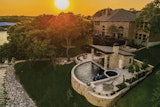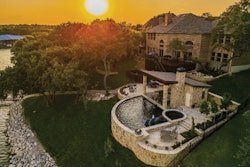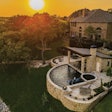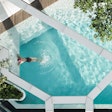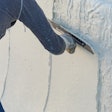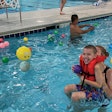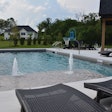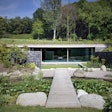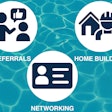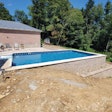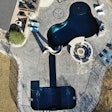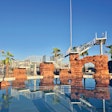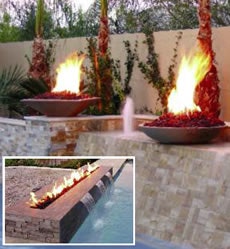
Drawing a parallel between ancient Greek philosophy and the modern-day pool and spa industry might be stretching it, but if you were paying even a little bit of attention this trade show season, you may have noticed a specific emphasis on combining the elements of fire and water. The trend of incorporating fire features into backyard projects is becoming difficult to ignore.
"There's no question that fire is not going away," says Joe Vassallo, president of Paragon Pools, a Las Vegasbased builder. "It's only going to be better and greater." Opportunities to enhance any waterscape with fire abound and new ways of achieving it are plentiful.
Beyond the Basics
By no means has the classic firepit gone away, but in many cases today it's being replaced with more-artistic options.
"I think more and more homeowners are seeing it in different places," says Kevin Doud, CEO of Grand Effects in Irvine, Calif. While the backyard oasis boom continues to gain momentum, customers are asking for features like the ones they see while vacationing at resorts across the world.
"These are entertaining areas," says Doud, referring to the firepits that double as a conversation area as well as a topic of conversation. "But the nice thing about fire areas is that they become not just a firepit, but a beautiful focal point of the job. It's a nice decorative piece that ties into the hearthscape that's been planned out. It doesn't have to be just around a standard firepit anymore."
Such non-standard features include fire bowls capping off raised pedestals, fire-and-water walls, fireand- water bowls, linear fire walls, fire troughs and fire spillways. While the bar for fire effects has been raised, one thing continues to remain somewhat unchanged: Fire features are commonly associated with high-end pool builders and projects.
"Higher-end pool builders know it sets them apart," says Doud. "When they show potential clients their portfolio, even if the homeowners don't go for it, it shows their capabilities as a pool builder."
Bob Roman, president of Las Vegas-based Fire By Design, has embraced decorative fire's growth within the industry and made a living out of it. "A customer said she wanted to have an outdoor fireplace as part of a larger project. Long story short, everything I showed her that I found online she didn't like. She said it was too boring, too boxy. So we ended up building it for her. And then I started getting requests for more," says Roman.
Roman turned those requests into weekly design-idea e-mails to inspire his clients and even non-clients to begin integrating decorative fire into their projects. The e-mails include a color photo of a finished project, CAD drawings in PDF format and a page of design notes. He also includes a list of parts Fire By Design fabricated for the job, as well as pricing. "We're trying to lead the charge in introducing new ideas," says Roman. "My original intent [for the e-mails] and still today's intent was just to broaden the thinking, to have a builder look at a job and add a little twist to his own job. I'm just trying to get people creative in their uses of fire. It's not just confined to a firepit or a bowl."
With creative use of fire comes the desire to integrate it with other highend additions of a pool, like a central remote controlled system for all the features. "People like technology," says Doud, "People want it." With many products on the market allowing homeowners to sync multiple devices, remote control fire is a reasonable way to go.
Sync With Automation
"Everybody wants automation," says Doud. "They like the idea that it ties into pool controllers and that they can turn it on and off with all of the other stuff they have tied into their system." The ease of automation allows builders a simpler installation, especially with packaged burners much like the ones Grand Effects designs.
The package systems are a complete unit. "It's just something you wire in and hook the hose up," says Doud. Most of the time, the package burners also require less maintenance, he adds.
Another reason to move toward automation is safety. "There are added benefits on safety with automation," says Doud. "We have built-in sensors that continually monitor the status of the flame so if the flame goes out because of wind or rain, it senses that it's out, and it shuts itself off." Like Grand Effects, Fire By Design also designs remote control fire modules. However, Roman's focus remains on remote control fire and water features, something that is just starting to take off.
"By and large, what I see is fire and water is where it's at, combining the two elements in the same space," says Roman. There are challenges to creating such smooth features that function by automation, though, in order for it to be functional - and safe - the electronics need to be away from the water.
"We've gotten a lot of requests for, 'We want to do remote control fire and have water come out of the spillway at the same time,'" says Roman. "And we've done a number of different things to accomplish that, but it was never easy."
The fire and water marriage is relatively new to Grand Effects. While it has been selling manual versions of its bowls and standard burning system, automated systems are now making their way to its line of products. When it comes to anything new, an educated client is still the best client. "More and more what I'm finding is that I'm getting requests from homeowners who are just interested in learning about fire," says Roman. "They just want to start gathering ideas." Toward that end, pages on Fire By Design's Web site are dedicated to educating visitors on the basics of incorporating remote control fire systems into a project.
However, the most important education is that of the officials inspecting fire and water projects.
The Future of Fire
The popularity of fire effects, and even their newness to industry inspectors, has caused a need to create some sort of standard code for installation. Although it is in its very early stages, Roman and Vassallo are drafting a chapter regarding fire effects with the goal that it will be certified by ANSI and added to the APSP Builders Manual. Eventually, Roman says, the objective "is to define the parameters for fire around water and get it into the ANSI book, as this [would be] gospel" to the building industry.
"The bottom line is it's all about educating pool builders and inspectors," adds Roman. "We're just trying to get awareness and get [standards] all up to par. If an inspector fails something today, a builder can't open up an ANSI book and say, 'Look, it's right here.' It isn't that this information doesn't exist, but they have nothing in their arsenal to show an inspector and say, 'Yes, this is in accordance with ANSI specification.' "That's the gray area. The gray area right now is huge. There's very little black and very little white," adds Roman. "We've learned a lot of things along the way, and I hope to share that with others so they can learn from the time I've spent in the field."
Fire's presence in the pool and spa industry is sure to remain on the forefront, leaving designers and builders a palette of possibilities. With its popularity steadily increasing, it's only a matter of time before the next great designer finds an even more innovative way to illuminate waterscapes with fire.


















